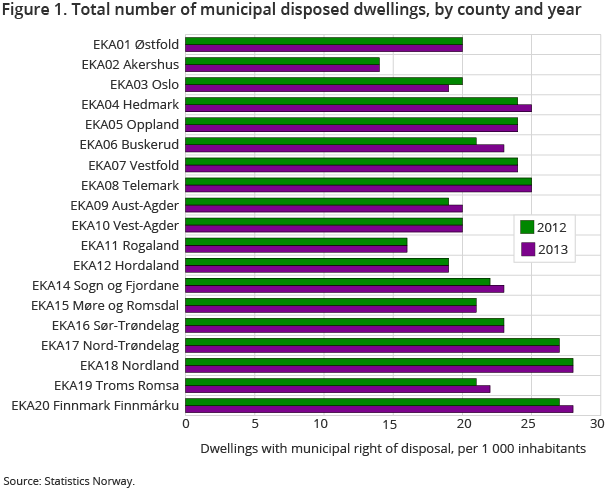Content
Published:
This is an archived release.
More municipal housing
There has been an increase of almost 2 per cent in municipal housing in 2013. More people with mental illnesses and/or substance abuse problems moved into municipal housing for the first time in 2013.
| 2009 | 2010 | 2011 | 2012 | 2013 | |
|---|---|---|---|---|---|
| Total number of municipal disposed dwellings | 96 403 | 100 918 | 101 670 | 103 164 | 105 144 |
| Dwellings with municipal right of disposal, per 1 000 inhabitants | 21 | 21 | 20 | 20 | 21 |
| Share of municipal dwellings accessible for wheelchair users | 43 | 45 | 46 | 47 | 48 |
| Net operating expenditures, public housing and related services, per capita in NOK | -28.4 | -30.3 | -10.8 | -2.5 | 40.5 |
| Gross operating expenditures, public housing, per dwelling with municipal right in NOK | 41 234 | 42 152 | 48 492 | 46 700 | 50 424 |

In Norway, there were about 105 000 municipal houses in 2013; 21 houses for every 1 000 inhabitants. Most of these houses, about 80 per cent, are owned by the municipalities themselves. This is the same level as 2012.
Norwegian municipalities received about 38 000 applications from households in 2013. This is a decrease of 1 per cent compared with 2012.
Five per cent of the households lived in temporary housing in 2013; a small increase compared with 2012.
Furthermore, about 18 per cent of the households were given municipal housing because they were refugees and 9 per cent because of mental illness. Nine per cent were housed because of substance abuse, which is an increase from the year 2012, when 7 per cent were in this category. Six per cent of the households receiving municipal housing were suffering from a combination of mental illness and substance abuse. In total, the group with mental illnesses and/or substance abuse problems has increased from 21 per cent in 2012 to 24 per cent in 2013.
Almost 16 per cent of households with other problems were given municipal housing in 2013.
The distribution between these groups has been relatively stable during the years 2009-2013, but the category other problems and people with mental illnesses and/or substance abuse problems is growing.
Contact
-
Unni Beate Grebstad
E-mail: unni.grebstad@ssb.no
tel.: (+47) 94 50 68 66
-
Wasif T. Hussain
E-mail: wasif.hussain@ssb.no
tel.: (+47) 40 90 24 09
